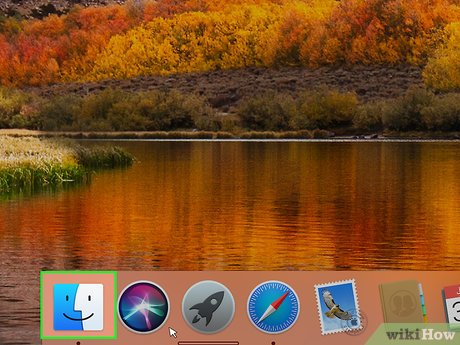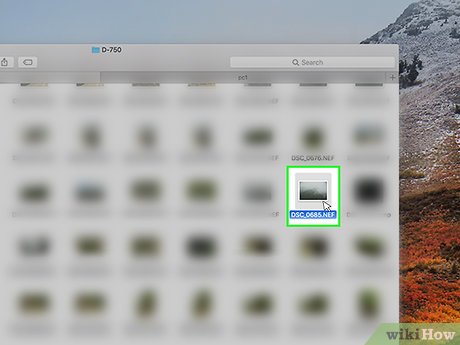How to Edit Images on a Mac
Part 1 of 7:
Opening the Image in the Preview App
-
 Open Finder. Open a new Finder window by clicking the icon of a blue and white smiley face located in the bottom-left of your Mac's dock.
Open Finder. Open a new Finder window by clicking the icon of a blue and white smiley face located in the bottom-left of your Mac's dock.
-
 Navigate to the photo you want to edit. Click the folder that contains the image you want to edit. For example, if you downloaded the image from the internet, it might be located in the Downloads folder.
Navigate to the photo you want to edit. Click the folder that contains the image you want to edit. For example, if you downloaded the image from the internet, it might be located in the Downloads folder. -
 Double-click the image file. By default, this will open the image in the Preview app. If images don't open in Preview automatically, you can right-click on the image file and select Open With and select Preview.
Double-click the image file. By default, this will open the image in the Preview app. If images don't open in Preview automatically, you can right-click on the image file and select Open With and select Preview.- If you are using a Magic Mouse or a trackpad, you can perform a right-click by clicking with two fingers.
Part 2 of 7:
Arranging the Image
-
 Clickto rotate the image. It's the icon of a square with a curved arrow over its top-right corner at the top of the Preview window. This will rotate the image 90 degrees counter-clockwise.
Clickto rotate the image. It's the icon of a square with a curved arrow over its top-right corner at the top of the Preview window. This will rotate the image 90 degrees counter-clockwise.
- Click the button as many times as you need to position the image to your liking.
-
 Click Tools. It's in the menu bar at the top of the screen. This opens a drop-down menu with additional options.
Click Tools. It's in the menu bar at the top of the screen. This opens a drop-down menu with additional options. -
 Select Flip Horizontal or Flip Vertical. It's near the bottom of the drop-down menu. Flipping the image horizontally will mirror the image from right to left, while flipping the image vertically will invert the picture from top to bottom, making the image appear upside down.
Select Flip Horizontal or Flip Vertical. It's near the bottom of the drop-down menu. Flipping the image horizontally will mirror the image from right to left, while flipping the image vertically will invert the picture from top to bottom, making the image appear upside down.- You can flip the image a second time to revert the image back to normal, or you can press ⌘ Command+Z to undo the last change.
-
 Click. It's the Markup Toolbar" button that resembles a marker tip inside a circle, located at the top of the window. This will open the Markup Toolbar displaying the various editing tools.
Click. It's the Markup Toolbar" button that resembles a marker tip inside a circle, located at the top of the window. This will open the Markup Toolbar displaying the various editing tools.
-
 Click. It's the icon that has the dotted outline of a rectangle. This will open a small drop-down menu.
Click. It's the icon that has the dotted outline of a rectangle. This will open a small drop-down menu.
-
 Click Rectangular Selection. It's the first option in the drop-down menu.
Click Rectangular Selection. It's the first option in the drop-down menu.- You can also click to select the elliptical selection tool, or the lasso tool, which allows you to draw your own selection.

- You can also click
-
 Click and drag the rectangle tool over the image. The dotted line of the rectangle indicates how the image will be cropped. Make sure the part of the image you want to keep are inside the rectangle marquee.
Click and drag the rectangle tool over the image. The dotted line of the rectangle indicates how the image will be cropped. Make sure the part of the image you want to keep are inside the rectangle marquee.- You can adjust the rectangle selection by clicking and dragging the blue dots (handles) in the corners of the rectangle.
-
 Click Crop. It's in the upper-right corner of the toolbar. This will delete everything except for what's inside the rectangle selection.
Click Crop. It's in the upper-right corner of the toolbar. This will delete everything except for what's inside the rectangle selection.
Part 3 of 7:
Adding Text
-
 Click. It's the icon of a "T" inside of a square in the Markup Toolbar. This will generate a text box in the center of the image that says "text".
Click. It's the icon of a "T" inside of a square in the Markup Toolbar. This will generate a text box in the center of the image that says "text".
-
 Click and drag the text box. You can drag the text box to any location in the image.
Click and drag the text box. You can drag the text box to any location in the image. -
 Type a text message. With the text box selected, type a message.
Type a text message. With the text box selected, type a message. -
 Clickto adjust the font. Click the button with the capital "A" to open a pull-down menu that allows you to change the text font, size, style, and orientation of the text.
Clickto adjust the font. Click the button with the capital "A" to open a pull-down menu that allows you to change the text font, size, style, and orientation of the text.
Part 4 of 7:
Adjusting the Image Colors
-
 Click. Click the "Color Adjust" button that resembles a prism with a ray of light running through it. This will open a menu that allows you to adjust the colors of the image.
Click. Click the "Color Adjust" button that resembles a prism with a ray of light running through it. This will open a menu that allows you to adjust the colors of the image.
-
 Adjust the color. Adjust the colors of the images with the following options.
Adjust the color. Adjust the colors of the images with the following options.- Curves: The graph at this top of the menu is the curves. You can adjust the curves by dragging the three tabs below the image. You can also click "Auto Levels" to automatically detect the best levels for the curves.
- Exposure: Drag the tab in this slider bar to make the image lighter or darker.
- Contrast: Drag the tab in this slider bar to adjust the contrast between the lighter and darker parts of the image.
- Highlights: Drag the tab in this slider bar to increase the lighter parts of the image.
- Shadows: Drag the tab in this slider bar to increase the darker parts of the image.
- Saturation: Drag the tab in this slider bar to strengthen or weaken the colors in the image.
- Temperature: Drag the tab in this slider bar to give the image a "warmer" or "cooler" tone.
- Tint: Drag the tab in this slider bar to add a red or green color overlay to the image.
- Sepia: Drag the tab in this slider bar to add a golden tint to the image.
- Sharpness: Drag the tab in this slider bar to sharpen or blur the image.
Part 5 of 7:
Adding Shapes to the Image
-
 Click the shapes button. It's the button that has a square and a circle. This will display a drop-down menu with various shapes. The shapes include a line, a rectangle, a rectangle with rounded images, an ellipse, a speech bubble, a star, and a hexagon.
Click the shapes button. It's the button that has a square and a circle. This will display a drop-down menu with various shapes. The shapes include a line, a rectangle, a rectangle with rounded images, an ellipse, a speech bubble, a star, and a hexagon. -
 Select a shape. This will generate the shape in the center of the image.
Select a shape. This will generate the shape in the center of the image. -
 Click and drag the shape. You can drag the shape to any location on the image.
Click and drag the shape. You can drag the shape to any location on the image. -
 Adjust the size of the shape. Click and drag the blue dots (handles) in the corners of the shape to adjust the size of the shape
Adjust the size of the shape. Click and drag the blue dots (handles) in the corners of the shape to adjust the size of the shape -
 Change shape color. Click the solid colored rectangle in the toolbar and select a color.
Change shape color. Click the solid colored rectangle in the toolbar and select a color.- The white box with a red line through it indicates no color.
-
 Change outline color. The outline is the line around the shape. Click the button that has a thick line in the shape of a rectangle. It's next to the solid colored rectangle button. Select a color for the outline of the shape.
Change outline color. The outline is the line around the shape. Click the button that has a thick line in the shape of a rectangle. It's next to the solid colored rectangle button. Select a color for the outline of the shape.- The white box with a red line through it indicates no outline.
-
 Change thickness of outline. Click the button with three lines of different thicknesses and styles.
Change thickness of outline. Click the button with three lines of different thicknesses and styles. -
 Select a thickness. There are seven line thicknesses to choose from.
Select a thickness. There are seven line thicknesses to choose from.- You can also select different line styles, such as dotted lines, arrows, and textured lines.
Part 6 of 7:
Drawing on the Image
-
 Click. It's the button with an image of a pen drawing a curve line.
Click. It's the button with an image of a pen drawing a curve line.
-
 Draw a line or a shape. You can draw anywhere on the image.
Draw a line or a shape. You can draw anywhere on the image. -
 Adjust the curve. You can adjust the curve after you draw by clicking and dragging the blue dots (handles) at the end of the line, or the green dot in the center of the curve.
Adjust the curve. You can adjust the curve after you draw by clicking and dragging the blue dots (handles) at the end of the line, or the green dot in the center of the curve. -
 Change the line thickness. Click the button with three lines of different thicknesses and styles.
Change the line thickness. Click the button with three lines of different thicknesses and styles.- You can also select different line styles, such as dotted lines, arrows, and textured lines.
Part 7 of 7:
Saving the Changes
-
 Click File. It's in the menu bar at the top of the screen.
Click File. It's in the menu bar at the top of the screen. -
 Click Save. It's in the file menu. This will save the changes you have made to the image.
Click Save. It's in the file menu. This will save the changes you have made to the image.
5 ★ | 1 Vote
You should read it
- How to create a command line program in Python with Click
- How to Drag and Drop
- The best iPad drag and drop apps running iOS 11
- How to bring file drag and drop - drag and drop back to Windows 11
- Steps to fix the error can't drag and drop in Windows 10
- How to Get Rid of a Horizontal Line in Microsoft Word
- How to Change the Wallpaper on a Mac
- How to set the default drag and drop file behavior on Windows 10
May be interested
- How to edit images in Word 2016
 photo editing, image formats in word 2016 will make images appear more professional in word, you can make cards, make cards and many other types of documents easier in word 2016 without the need for additional software.
photo editing, image formats in word 2016 will make images appear more professional in word, you can make cards, make cards and many other types of documents easier in word 2016 without the need for additional software. - How to edit photos to fit the desktop on Windows 10
 you have just set up an image as a desktop or lock screen, but not satisfied with how to cut the image of windows 10?
you have just set up an image as a desktop or lock screen, but not satisfied with how to cut the image of windows 10? - Instructions for editing photos on Icecream Photo Editor
 icecream photo editor is an image editing software that owns many basic photo editing tools, such as cropping images, adding text to images or can create collages from many different images with available collage frames.
icecream photo editor is an image editing software that owns many basic photo editing tools, such as cropping images, adding text to images or can create collages from many different images with available collage frames. - How to create spherical images in GIMP
 in this tutorial, we will learn how to create spherical collage images using the ellipse select tool and the spherize filter that comes with gimp.
in this tutorial, we will learn how to create spherical collage images using the ellipse select tool and the spherize filter that comes with gimp. - How to edit images on Copilot AI
 in addition to the image creation feature on copilot ai, users can now edit those images right in copilot without having to use additional image editing software.
in addition to the image creation feature on copilot ai, users can now edit those images right in copilot without having to use additional image editing software. - How to use AI Image Editor to edit photos with AI
 to edit photos online, it's not difficult to find a tool you like with many different editing features. however, ai image editor is completely different as the website uses ai technology to edit images.
to edit photos online, it's not difficult to find a tool you like with many different editing features. however, ai image editor is completely different as the website uses ai technology to edit images. - How to rotate images in Word
 how to rotate images in word. an extremely useful feature built on word is that it supports users to insert images into documents to illustrate or introduce products, services, etc. images are inserted into word documents. can edit s
how to rotate images in word. an extremely useful feature built on word is that it supports users to insert images into documents to illustrate or introduce products, services, etc. images are inserted into word documents. can edit s - Edit command in Windows
 the edit command starts ms-dos editor, creates and changes ascii text files.
the edit command starts ms-dos editor, creates and changes ascii text files. - Insert images into Word 2016 and align images in Word 2016
 adding images to word 2016 is a way to make your document more attractive, easily highlighting important information with photos and adding emphasis to existing text.
adding images to word 2016 is a way to make your document more attractive, easily highlighting important information with photos and adding emphasis to existing text. - How to replace art background image with PicsArt
 picsart is a photo editing application on your phone, which allows users to freely edit their images, such as splitting background images and integrating images.
picsart is a photo editing application on your phone, which allows users to freely edit their images, such as splitting background images and integrating images.


















































 How to Boot a Mac from Firewire
How to Boot a Mac from Firewire How to Make an Interactive Desktop Background
How to Make an Interactive Desktop Background How to Add Email Accounts to a Mac
How to Add Email Accounts to a Mac How to Start Screensaver with a Keyboard Shortcut on Mac
How to Start Screensaver with a Keyboard Shortcut on Mac How to Make a Movie of Yourself on a Mac
How to Make a Movie of Yourself on a Mac